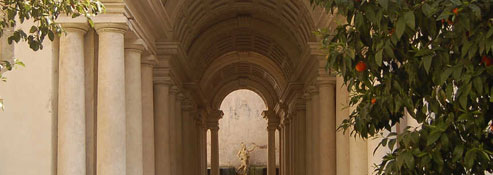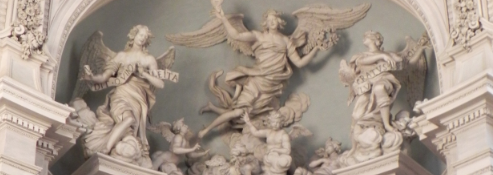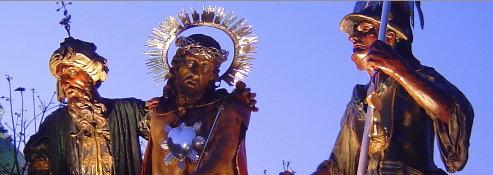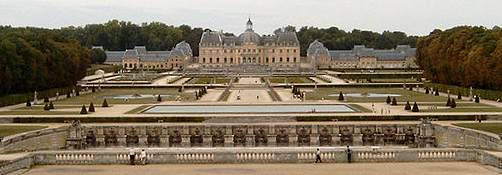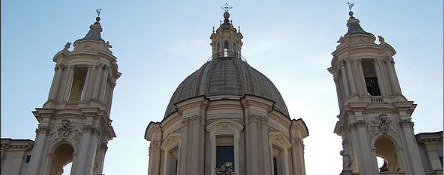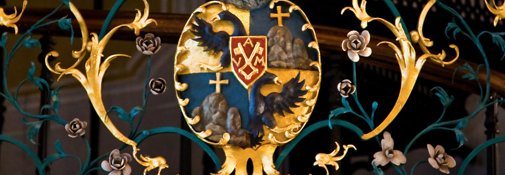By drawing a comparison of Italian and French culture Pier Jacopo Martello describes the effects of Italian poetry:
Così interviene, che gl'individui colle immagini vaghe, ed amene ricreinsi, e le passioni colla ragione si temperino, perchè Dio stesso, confacendosi piacevolmente alla debolezza umana, ha quest'util fantasia secondato, ispirando fino a i Profeti gli oracoli suoi di queste immaginazioni vestiti, le quali colla vaghezza loro negl'intelletti degli uomini la verità mascherata di queste pompe di fantasia introducessero, onde più accetta, e non men venerabile si rendesse. [...] Ma perciocchè vorressimo [!], incontentabili, che noi siamo, che il nostro parlare fosse ancor più perfetto di quel, che è; e con piacere le arcate delle viuole [!], e il pizzicar delle cetere penetrando negli animi nostri, in diletto più che ordinario li avvolgono, noi conformando le voci, e le parole al suono degli armoniosi istrumenti quanto per noi si può uniformando, in misurati periodi colle musiche note li restringiamo, dalla quale industria poi nacque il verso fluido, ritondo, e colante, il quale finisce di rendere amabili non meno a chi le riceve, che a chi le porge, queste giovevoli illusioni di fantasia. [1]
This passage is taken from a text Martello recited in 1718 during a carnival festivity, which was published in the Prose degli Arcadi in the same year. The text, Il parigino italiano. Commedia didascalica divisa in tre atti, juxtaposes the developments in literature and culture in France and Italy highlighting the Italian supremacy. Despite its recitation during carnival - which could imply that the work must be understood ironically [2] - we must contextualise the "comedy", actually without any dialogic structure and resembling a novel, in the contemporary debate on the value and sophistication of Italian poetry. It was mainly initiated by the French Jesuit Dominique Bouhours in 1687. One of the many supporters of Italian poetry in this cultural rivalry between the two nations was Martello, together with e.g. Gian Giuseppe Felice Orsi, Ludovico Antonio Muratori, Gian Vincenzo Gravina and Giovanni Mario Crescimbeni. [3]
But what is the meaning of the cited text passage? What kind of literary concept does it expose? First, Martello points out the delight and utility of poetry referred to earlier in his text. He does this according to the well-known doctrine of Horatio: "Aut prodesse volu[n]t, aut delectare Poet[a]e, / Aut simul & iucunda, idonea dicere vitae" or "Ò giovare, ò piacer vuole il Poeta: / Ò dir cosa, che piaccia, e giovi insieme". [4] The "piacere" is effectuated by pleasant images - metaphors and rhetorical figures -, the "giovare" by the fact that these images recreate man - thus enabling him to fulfil his duties in society - [5] and that poetry itself is a catalyser for the moderation of the passions, by means of reason. It is a common view in Arcadian literary theory that poetry must fulfil the premise of utility: Muratori points out that poetry should reflect the principles of ethics. Gravina and Crescimbeni are more general in this respect. [6] It is obvious that they are following antique conceptions of the utility of the arts, best known through Plato's Politeia. [7] To explain his view Martello compares contemporary poetry to the Sacred Bible: God too speaks in images, metaphors and rhetorical figures, thus in a pleasant textual form, to transmit his secret messages to the faithful. In this way Martello accepts the scholastic concept of the fourfold interpretation of the Bible (literal, allegorical, tropological, anagogical). [8] He understands the Scripture and consequently poetry as highly ciphered genres in need of an interpretation. Then Martello explains that messages can most effectively be transmitted when presented in a musical dress. Merely the goal to set a text to music, leads the poet to write an attractive poetic structure. This appealing poetry is well received by the listener as well as by the performer.
To sum it up: not any poetry, but poesia per musica, that is poetry destined to be set to music, is the best literary genre to guarantee "piacere" and "giovare" for Martello. Its imagery creates pleasure, when interpreted it creates utility. Utility is equally achieved by the fact that poesia per musica causes recreation through its imagery and musical setting - and that it functions as a means to control the passions if reason is involved.
When we adopt this notion of poesia per musica of the first half of the 18th century there are more or less three musico-literary genres corresponding to Martello's ideas in Italy: the cantata da camera, the dramma per musica and the oratorio. We can omit sonnets, canzoni, madrigals, odes etc. simply because they are only set to music on rare occasions. In this paper I will focus on the cantata da camera and investigate if and how the cantata can be seen with regards to contents as a means to temper the passions.
In cantatas, this objective is by no way self-evident because they normally are orientated in other directions. It is true that cantata subjects are characterised by a high variability, but the most frequent topic is love: a shepherd loves a shepherdess or vice versa. The main characteristic of these love scenes is a mainly exaggerated expressivity and emotionality, both in regards to poetic language and music. This is more apt to excite passions than to temper them.
A text like the following, contemporary to Martello, although presented in a "controlled" form (the verse), lacks every restraint in describing violent passions and does not show any rudiments for a control over them:
Barbara, ingrata Fille,
E perché tanto sdegno e tanto orgoglio?
Se non brama il mio cor da tue pupille
Che un guardo solo à un innocente foglio:
E perché tanto sdegno e tanto orgoglio?
Un cor, che per te more,
Ne chieder può mercè;
Così, crudel, ti chiede
Almen qualche pietà.
Aita al suo dolore
Non vuol giamai da te;
Ma brama alla sua fede
Men sdegno e crudeltà
Ah, ben cruda sei tu, mentre t'offende
La fanella d'amore.
Ogni fiera più cruda ed inumana
Agl'accenti d'amor d'amor s'accende.
L'erbe, gl'augelli, i fior, la selce, il rio
Al nome sol del faretrato Dio
Ardono in dolce fiamma ed hanno allora
Pietà della cagion, che l'innamora.
E tu sola senz'alma e senza core
Senso non hai per l'amoroso ardore?
Nume arciero con dardo fatale,
Apri il seno di Fille crudel.
Pur che senta pietà del tuo male,
Vengan pure
Le sventure
À dar morte al mio core fedel.
(text: unknown, music: Alessandro Scarlatti, 1706) [9]
In another text a shepherdess insults her lover Fileno:
Tu fedel? tu costante? ah non è vero!
T'usurpi ingiustamente
Titoli così belli, empio Fileno.
Tu fedel? cui scintillano nel seno
Sempre nove faville.
Tu costante? ch'il cuore vanti
Diviso in mille parti in mille.
Incostante, infedele, traditore!
Questi, Fileno, questi
Giusti titoli sono e pregi tuoi,
Onde superbo ir puoi,
Spergiuro, menzogniero.
Tu fedel? tu costante? ah non è vero!
Cento belle ami, Fileno,
E poi vanti avere in seno
Un costante e fido cor.
Stolta è ben colei, chi crede,
Ch'in te sia costanza e fede,
Empio, infido, mentitor.
[…]
(text: unknown, music: Georg Friedrich Händel, 1706/07) [10]
A text set to music around the time of Martello's speech depicts the shepherd's pains and his accepted destiny to die:
In onta à tuoi disprezzi,
Orgogliosetta Irene,
Mi costringe il destino
D'adorar quel tuo volto ancor che infido.
Gelosia mi tormenta,
Il tuo ardir mi divora
E pur quest'alma amante
Fra i gemiti e sospiri
Vive sempre costante,
Acciò comprendi un dì, che la mia fede
Forse degna sarà di tua mercede.
Con la speme di vedervi,
Luci amate un dì pietose,
Non pavento il rio martir.
Pur ch'io possa in tante pene
Dirti ò cara: sei il mio bene,
Mi sarà dolce il languir.
Che, se poi del mio core
Disprezzi anche l'ardore,
Dovrò morir; mà senti,
Pria che l'alma fedele
Mi lasci e scendi à Pluto,
Mora fra le tue braccia
Mesta languente e fida,
Se amandoti fedel mai ti fù infida.
Incontrerò la morte
Forse con miglior sorte
Di quel, che in vita avrò.
T'amai costante in vita
E nella morte ancora
Fedele io t'amerò.
(text: unknown, music: Antonio Caldara, 1716 or later) [11]
In these examples a person originating from an Arcadian context, a shepherdess or a shepherd, constantly violates the laws of aristocratic behaviour through passionate outbursts. The display of passions is intensified through the musical setting. As Pier Francesco Tosi wrote in his treatise on singing in 1723 the presentation of passions and emotions in the cantata was the major task of the singers: "Questo [recitativo da camera] esige quasi sempre un particolar artificio a cagion delle parole, le quali essendo dirette (poco men che tutte) allo sfogo delle passioni più violenti dell'animo, impegnano l'Istruttore di far imparare al suo Allievo quel vivo interesse, che arriva a far credere, che un Cantore le sente. [...] E vaglia'l vero, dove parla la passione i Trilli, e i Passaggi devon tacere, lasciando che la sola forza d'una bella espressiva persuada col Canto." [12] This is in fact important because cantatas are closely linked to aristocratic society: nobles wrote cantata texts, they commissioned their musical settings, they arranged cantata performances in noble gatherings, they collected them and gave them away as presents befitting one's rank. [13] But the public display of violent passions, insults, desires of death, melancholy and so on are in no way consistent to the aristocratic codes of conduct of that time. On the contrary, aristocrats were obliged to self-control and control over the passions. The dichotomy between the textual and musical realisation as well as the performative aspects of the cantata da camera and the objective of poetry expressed by Martello is evident.
But how can we define the aristocratic codes of conduct? A good starting point are contemporary books on ethics published in Italy. They provide an important opportunity to advance the understanding of the commonly accepted rules of conduct. These treatises must have been well known since they were used as teaching material in the Collegi dei nobili and republished about 20 times after their first publication. I refer to La filosofia morale derivata dall'alto fonte del grande Aristotele stagirista by Emanuele Tesauro, first published in 1670 and republished until 1729 [14] and to La filosofia morale esposta e proposta a i giovani by Ludovico Antonio Muratori, first published in 1735 and republished until as late as 1827. [15] Based on Aristotle's Nicomachean Ethics the authors extensively discuss the behavioural norms and the passions that have to be controlled for being a "perfect" man. [16]
According to contemporary ethics the passions are not dangerous for man per se. On the contrary, they are necessary for human action. Only excesses have to be condemned. [17] Via the control over the passions it is possible to achieve a "mediocrity" [18] assuring an ever-steady appearance in society. [19] Having a look on the cantate we miss this "mediocrity" and observe verbal and mental excesses instead. The persons speaking to the listener do not apply to "temperanza", "modestia", "prudenza" and "amabilità" or "affabilità", virtues and means to temper the passions so much favoured by ethics. [20] Within cantata texts one can find many references of "incorrect" conduct: passionate outbursts like insults, jealousy, fury, rage or the desire of death and so on. In other words: with regard to contents (not to textual form) cantatas show how explicitly not to behave.
Bearing in mind this "incorrect" passionate behaviour, how could cantatas be seen as medium of control over the passions? In the following I will try to explain the dichotomy, presenting some hypothetical thoughts based on literary theory, ethics and communication science - hypothetical, because little is currently known about the reception of cantatas by contemporary audiences.
Firstly, we have to bear in mind that in cantatas shepherds and shepherdesses are speaking, that is - in terms of classical decorum - individuals of a lower rank than the mostly noble audience - despite their refined language and despite the possibility that shepherds could be role models for the ruling class. [21] For members of the lower classes passionate behaviour is not inappropriate. Secondly, it is important that the protagonists are often located in solitude. They are by no means speaking to a counterpart - a second person is addressed, but does not enter in the soliloquy - but lamenting in privacy. Acting out passions hidden from society is indeed acceptable. However, this does not exactly help to explain why cantatas could be a medium of passion control.
A passage pointing to the fact that the cantata could be used for prevention purposes is found in a text by the Arcadian Vincenzo Leonio from 1698. Writing on love poetry Leonio states that this kind of poetry does not corrupt, but instruct morals because it shows the strange effects of love which is the source of all sorts of passions [22] - and, here we add, which should not be followed because it contradicts ethical rules. He sees the need of interpretation of love poetry in a neo-platonic sense: "[…]: ma se tu biasimi i soggetti d'onesti amori, onestamente trattati, come è costume degli Arcadi, il fai senza alcuna ragione; poiché questi non corrompono, ma istruiscono i costumi, dimostrando gli strani, e maravigliosi effetti d'Amore, da cui tutte l'altre nostre passioni traggon l'origine; e sollevando la nostra mente dalla caduca bellezza del corpo all'immortale dell'anima, e da questa alla suprema, ed infinita dell'Altissimo Iddio: […]." [23] The correspondence to Martello's view is striking. According to Leonio, the use of poetry - and implicitly of poesia per musica - lies in the demonstration of moral deviations and, on a second, more intellectual level, in its interpretation in a moral sense.
There is another concept going in line with passion control: Aristotelian catharsis. Its aim, as defined in antiquity, was the demonstration of horror in tragic action causing terror and compassion in the audience. In the 17th and 18th century in France and Germany the conception of catharsis was mainly connected with the conception of control over the passions: terror and compassion adopt a catalytic function in the process of passion control. They should help the reader and onlooker not to make the same mistakes as the figures in the tragedy. [24]
However, in Italy this concept of catharsis was only partially adopted, so that in the 17th century catharsis was confused with rhetorical or moral persuasion. [25] Not until 1700, when Arcadians like Martello, Gravina and others began to write tragedies, a different view was followed though the older idea was not completely abandoned. [26] At this time, literary theory saw contemporary dramma per musica as a further developmental stage of the tragic genre: operas were solely seen as sung tragedies, thus complying with the contemporary understanding of antique tragedy as drama with music. Also the literary theory often condemned contemporary musical style, [27] as well as the lieto fine, characteristic for both, spoken and sung tragedies, which tempers the horror of the tragic action (if we can call the bizarre, absurd and erratic opera plots tragic at all). [28]
But when suppressing the horror with lieto fine, are sung "tragedies" able to cause catharsis? And isn't it hazardous to compare the cantata, a basically un-dramatic poetical form, with tragedy? At least the scopes of tragedy and cantata seem to be similar: they present "horrible" cases and should conform to the requirement of utility.
Catharsis is defined by Martello as a mechanism to replace an evil by another: passions are extinguished by those seen on stage. [29] Gravina understands the horror presented as a means to become familiar with terror and compassion. [30] But there is still another point to consider: As we have already seen cantatas present extreme emotions and modes of behaviour inconvenient for an accomplished human being. If we adopt the model of the doctrine of affections, ever virulent in the 17th and 18th century, that man should be moved by music and be affected like a string put into vibrations by a vibrating string, [31] cantatas should have caused the same effect - with the only restriction that emotional reactions of the listener should not be shown in public. The inner reliving of extreme passions however resembles the modern, psychological "catharsis hypothesis" of communication science. This - in the meantime disproved - concept tries to explain the role of media in regards to potentials of aggression. It assumes that a viewer is able to reduce his aggression when participating inwardly in a violent action executed by an actor in lieu of him. [32] Transferred to the cantata, the inner reliving of extreme passions could effect their reduction because the shepherd/singer becomes "guilty" of misconduct in place of the listener, a misconduct the latter never will commit.
But the texts presented are only one facet of the various kinds of poetic cantata "librettos". There is at least one kind which could directly be responsible for provoking passion control. These texts expose virtues and provide instructions how to act. The following text at first glance seems to deal with the common love theme, but the keyword is "costante": in all the vicissitudes of love constancy is a value that must be followed.
Amo, peno, gioisco,
Soffro, spero, pavento
Frà la gioia e il tormento.
Agitato languisco
E l'alma audace,
Perché troppo vorrebbe, adora e tace.
Per non offendere, chi tanto adora,
D'ovrà quest'anima languir nel foco.
Potrei pretendere un guardo solo,
Mà un guardo misero è troppo poco.
Soffri dunque, cor mio,
E se sperar non puoi
La dovuta mercede
À un alma amante,
Ti basti esser costante.
Pena, taci et adora,
Che il penar, per chi s'ama, è premio ancora.
Mi basterà l'amarvi,
Mi basterà il mirarvi,
Ò luci belle, ò luci amate.
Solo vorrei, che almeno,
Cara, sentissi in seno,
Se non foco d'Amore
Almen pietade solo vorrei.
(text: unknown, music: Giovanni Bononcini, ca. 1706) [33]
Constancy is normally not a separate virtue, but subordinate to one of the four cardinal virtues, "fortezza" (fortitude). In Agostino Paradisi's monumental work on nobility it is described as "fortezza costante", in Muratori's Filosofia morale it is defined as a modus operandi of "fortezza". [34] The highly interpretative layout of poesia per musica as postulated by Martello and Leonio suggests that the love theme of the cantatas could be understood in a different way. Love is a category in the relationship between friends and between prince and courtier or patron and client. [35] The text could be read as a plea for constancy in a relationship of not returned affection. In fact through constant "love" the favour ("mercede") of the prince or patron could be won. Hence, the cantata above exposes an exhortation not to abandon the virtue of constancy in turbulent and apparently hopeless circumstances.
Conclusion
How can cantatas be efficient in controlling the passions? This is not an easy question to answer. But it seems that Martello's view as expressed in his "comedy" harks back to antique ideals of use and pleasure, resulting in highly imagery texts to be interpreted. The control over the passions may be effected on three ways: First, the reader or listener must not understand the texts literally, but reach a higher abstraction level which enables him to their interpretation ("colla ragione"). This higher level can be the reason that cantatas may provoke the control over the passions by interpreting the "cases" exposed as deviations from behavioural norms. A second way is based on the concept of catharsis: the listener inwardly relives the violent passions presented by the performer. This causes his release from passionate extremes. A third way discusses virtues and gives guidelines so as not to be overwhelmed by passions and for pursuing the right, virtuous path.
It is, however, another question if this function of poetry in general and poesia per musica in particular represents an ideal by literary theorists for constituting meaningfulness or legitimation or if it is an anchored and commonly accepted conception. [36]
Notes
1. P.J. Martello, Prosa XIII. Il parigino italiano. Commedia didascalica divisa in tre atti dello stesso Mirtilo Dianidio [P.J. Martello] recitata da lui in Serbatoio d'Arcadia la sera di Carnasciale l'anno 1718. Ad Alarco Erinnidio Pastore Arcade [G.G.F. Orsi], in G.M. Crescimbeni (ed.), Prose degli Arcadi, Roma 1718, vol. 2, pp. 187-286: 266-267; republished five years later as Il vero parigino italiano in Martello's Opere (vol. 5, Bologna 1723, pp. 289-370: 354-355).
2. This, however, makes no difference because the passage would criticize a view definitely existing in Martello's time.
3. A. Asor Rosa, Storia europea della letteratura italiana, vol. 2: Dalla decadenza al Risorgimento, Torino 2009 (Piccola Biblioteca Einaudi. Nuova serie 427), pp. 167-174; M. Piccolomini, Il pensiero estetico di Gianvincenzo Gravina, Ravenna 1984, pp. 31-32. The publications referred to are: D. Bouhours, La manière de bien penser dans les ouvrages d'esprit. Dialogues, Paris 1687; G.F. Orsi, Considerazioni sopra un famoso libro franzese intitolato La maniere de bien penser dans les ouvrages d'esprit cioè La maniera di ben pensare ne' componimenti divise in sette dialoghi ne' quali s'agitano alcune quistioni rettoriche, e poetiche, e si difendono molti passi di poeti, e di prosatori italiani condannati dall'autor franzese, Bologna 1703; L.A. Muratori, Della perfetta poesia italiana spiegata, e dimostrata con varie osservazioni [, e con varj giudizj sopra alcuni componimenti altrui,] […], tomo primo [secondo]. All'Illustrissimo, ed Eccellentissimo Sig. March. Alessandro Botta-Adorno […], Modena 1706; G. Gravina, Della ragion poetica libri due, Roma 1708; G.M. Crescimbeni, L'istoria della volgar poesia, 6 vol., Roma 1698; id., Commentarii alla sua Istoria della volgar poesia, 5 vol., Roma 1702-11; id., La bellezza della volgar poesia […]. Riveduta, corretta, e accresciuta del Nono Dialogo dallo stesso autore, e ristampata d'ordine della Ragunanza degli Arcadi. All'Eminentissimo, e Reverendissimo Principe il Cardinal Lorenzo Corsini, Roma 1712. Cfr. too Maria Grazia Accorsi, Pastori e teatro. Poesia e critica in Arcadia (Il vaglio. Studi e documenti di storia della cultura italiana, 39; Modena 1999), pp. 241-296.
4. Q. Horatius Flaccus, L'arte poetica […] tradotta da Paolo Abriani, Venezia 1663, pp. 36-37. This publication is dedicated to Camillo Pamphilj and his 15 and 10 year old sons Giovanni Battista and Benedetto. The latter was a poet himself and member of Arcadia (Fenicio Larisseo) later. The popularity of Horatio's doctrine is corroborated by many Italian translations published during the 17th and 18th century: Naples 1610 (Scipione Ponzio), Rome 1630 (Lodovico Leporeo), Venice 1663 (Paolo Abriani), Venice 1680 (Abriani), Bologna 1686 (Loreto Mattei), Ferrara 1694 (Giulio Cesare Grazzini), s.l. 1698 (Giambattista Vacondi), Bologna/Milan 1714 (Mattei), Siena 1714 (Pandolfo Spannocchi), Venice 1726 (Benedetto Pasqualigo), Milan 1726 (Giovampaolo della Torre Rezzonico), Venice 1734 (Francesco Borgianelli), Milan 1735 (Pasqualigo), Venice 1738 (Borgianelli), Rome 1748 (Bernardo Bucci), Venice 1750 (Borgianelli) etc. Cfr. the editions in www.internetculturale.it (consultation 8 March 2014); Biblioteca degli autori greci, e latini volgarizzati L-R, in Raccolta d'opuscoli scientifici e filosofici, vol. 46, Venice 1746, "Orazio": pp. 302-315. On Benedetto Pamphilj see the dissertation by L. Hinden, Die Kantatentexte von Benedetto Pamphilj (1653-1730) (mit vollständiger Edition), Kassel 2014 (forthcoming) (MARS - Musik und Adel im Rom des Sei- und Settecento / Musica e aristocrazia a Roma nel Sei- e Settecento 2).
5. Muratori, Della perfetta poesia italiana cit., vol. 2, p. 5: "Ed oltre a ciò il Diletto medesimo, che da essi [poemi] è prodotto, viene ad essere in qualche maniera di utilità alla Repubblica, ricreandosi col mezzo d'esso gli animi de' Cittadini; non altrimenti che si faccia dalla Musica, e da altre Arti, le quali son giovevoli al Pubblico, benchè destinate al solo ufizio di recar diletto."; P.M. Doria, La vita civile […] con un trattato Della educazione del Principe. Terza impressione, dall'autore ricorretta, e di molte aggiunzioni adornata. Dedicata all'Illustriss. ed Eccellentiss. Sig. il Signor D. Stefano de' Marini Principe di Striano, &c., Napoli 31729 (first edition Augsburg 1710), pp. 3, 183-186.
6. Muratori, Della perfetta poesia italiana cit., vol. 2, p. 1-11: he claims explicitly that poetry should be "figliuola, o ministra della Filosofia Morale, Maestra de' buoni costumi, e giovevole alla Vita Civile" (p. 7, similar p. 11 and more detailed vol. 1, p. 42-46); Gravina, Della ragion poetica cit., pp. 20-21: he sees the role of poesia in transferring ideas and truths in a pleasant, sensible form to lower classes; Crescimbeni, La bellezza cit., p. 51: "I fonti poi dell'utilità […], che sono gl'insegnamenti, che sotto il velame Poetico si contengono, i quali da ogni scienza possono esserne porti: ma spezialmente dalla Teologia, dalla Metafisica, dalla Fisica, dalla Politica, e dall'Etica: […]". Cfr. also P.M. Doria, Della educazione del principe, in id., La vita civile cit., p. 463: "[…] la poesia ha bisogno di fantasia colta, ma accesa, per rappresentare con immagine viva e forte quelle verità, che si vogliono ispirare nell'animo di chi legge, e d'invenzione, che ajuti la forza dell'immagine, e trattenga con diletto l'animo dell'ascoltante; sicchè senza pena o travaglio si senta istillar nell'animo e negli affetti le buone massime della filosofia, in modo tale che non solamente egli le intenda, ma ardentemente ancora del loro amore si accenda; […]." On the effects of poetry as they emerge in Gravina's works cfr. E. Sala di Felice, L'età dell'Arcadia, Palermo 1978 (Scuola e cultura 5), pp. 102-105.
7. Plato, Politeia, 398c et seqq. On the reception of antique theories cfr. D. Helms, Die Rezeption der antiken Ethoslehre in staatstheoretischen und pädagogischen Schriften und die Beurteilung der zeitgenössischen Musik im Humanismus, in A. Rolf, U. Tadday (eds.), Martin Geck. Festschrift zum 65. Geburtstag, Dortmund 2001, pp. 325-351.
8. The doctrine of the fourfold interpretation of the Bible goes back to medieval scholastics and is e.g. described in the Summa of Thomas Aquinas. See Die deutsche Thomas-Ausgabe. Vollständige, ungekürzte deutsch-lateinische Ausgabe der Summa Theologica, Salzburg/Leipzig 1934, p. 30.
9. Hannover, Stadtbibliothek, Musikbibliothek, Kestner 73; see also Clori. Archivio della cantata italiana, www.cantataitaliana.it, record 1394 (consultation 1 May 2014).
10. Münster, Diözesanbibliothek, Santini-Sammlung, Sant.Hs.1910 and 1913; see also Clori. Archivio della cantata italiana, www.cantataitaliana.it, record 4410 and 4413 (consultation 1 May 2014).
11. Münster, Diözesanbibliothek, Santini-Sammlung, Sant.Hs.754; Wien, Gesellschaft der Musifreunde, VI 16569; see also Clori. Archivio della cantata italiana, www.cantataitaliana.it, record 2345 and 5040 (consultation 1 May 2014).
12. P.F. Tosi, Opinioni de' cantori antichi e moderni, o sieno Osservazioni sopra il canto figurato (Bologna 1723), repr. London 2009, pp. 41-42.
13. B. Over, Zum sozialen Kontext von Händels römischen Kantaten, in H.J. Marx, M. Calella (eds.), Händels Kirchenmusik und vokale Kammermusik, Laaber 2012 (Das Händel-Handbuch 4), pp. 325-343.
14. See the editions in Internet culturale: www.internetculturale.it (consultation 4 february 2014).
15. See the list of editions on the website of the Centro di studi muratoriani, Modena: www.centrodistudimuratoriani.it (consultation 4 February 2014). On their use in the Collegi dei nobili cfr. G.P. Brizzi, La formazione della classe dirigente nel Sei-Settecento. I seminaria nobilium nell'Italia centro-settentrionale, Bologna 1976 (Saggi 164), p. 233.
16. They are even more important than Descartes' Des passions de l'âme because Descartes' book of 1649 was obviously not commonly accepted. This can be seen in the fact that it only partially influenced later passion theories. Cfr. C. Newmark, Passion - Affekt - Gefühl. Philosophische Theorien der Emotionen zwischen Aristoteles und Kant, Hamburg 2008 (Paradeigmata 29), p. 143. Tesauro and Muratori do not seem to have been influenced by Descartes because they retain the doctrine of appetite as the trigger of the passions rejected by the French philosopher. Moreover in contrast to other French doctrines of the affections no Italian translation of Descartes' famous book existed in the 17th and 18th century. It was however available in a Latin translation for example in some Roman libraries (library of cardinal Imperiali and Biblioteca Casanatense, not in library Capponi and Biblioteca Chigiana), thus implying a rather scientific quality. Bibliothecae Josephi Renati Imperialis Sanctae Romanae Ecclesiae Diaconi Cardinalis Sancti Georgii catalogus secundum auctorum cognomina ordine alphabetico dispositus una cum altero catalogo scientiarum & artium, Roma 1711, p. 152 (ed. Amsterdam 1677); Bibliothecae Casanatensis Ordinis Praedicatorum catalogus librorum typis impressorum, vol. 2, Roma 1768, p. 580 (ed. Amsterdam 1664). Regarding the other two libraries cfr. Catalogo della Libreria Capponi o sia de' libri italiani del fù Marchese Gregorio Capponi Patrizio Romano, e Furiere Maggiore Pontificio con Annotazioni in diversi luoghi, e coll'Appendice de' libri latini, delle miscellanee, e dei manoscritti in fine, Roma 1747; Catalogo della Biblioteca Chigiana giusta i cognomi degli autori ed i titoli degli anonimi coll'ordine alfabetico disposto sotto gli auspicj dell'Eminentissimo e Reverendissimo Prencipe Flavio Chigi della S.R.C. Diacono Cardinale di S. Maria in Portico, ed. by Stefano Evodio Assemani, Roma 1764.
17. Tesauro, La Filosofia morale cit., 1712 ed., p. 120: "Se non è saviezza il non haver le passioni; ma il sapersene ben servire come de' cavalli, delle armi, delle ricchezze. Non son virtù, ma si possono cangiare in virtù; dominandole, senza lasciarsi dominare." Muratori, La filosofia morale cit., 1735 ed., p. 181: "Ora basta intendere, cosa sono gli umani Affetti, per intendere tosto ancora, ch'essi non men delle Membra sono utili e necessarj alle Azioni dell'Anima umana." Cfr. also Doria, La vita civile cit., p. 3: "[…]: imperocchè le passioni hanno il loro utilissimo uso nell'umana natura, quando sono alla ragione conformi: e che privare un'uomo delle passioni sarebbe lo steßo, che ridurlo privo d'ogni facultà di operare; permodochè verrebbe a farsi il filosofo tale, qual viene sempre dal volgo riputato, cioè stolido ed inutile alla vita civile. Che le passioni, siccome mal dirette, ed in ecceßo son valevoli a far un'uomo scellerato; così quando camminano di paßo concorde con la ragione, sono quelle sole, che forman l'Eroe, e le vere madri delle virtù più eminenti."
18. Tesauro, La filosofia morale cit., 1712 ed., p. 77: "[…] la virtù altro non è che una mediocrità frà gli estremi viziosi."; p. 78: "Perche la virtù non è altro, che una mediocrità prescritta dalla ragione; il che chiude tutte le virtù, e sorchiude tutti gl'estremi."; p. 542: "Rispondo, la ragione le [le passioni] regola in due maniere. […] Moralmente, riducendole alla mediocrità nella guisa, che à luogo suo si è ragionato; cioè, fuggendo gl'estremi, e misurando le circostanze." Muratori, La filosofia morale cit., 1735 ed., p. 203: "Osservò poscia Aristotele, che le più delle Virtù consistevano nella Mediocrità, e volle dire che erano poste in mezzo a due Estremi, cioè al Difetto, e all'Eccesso, […]." The concept originates from Aristotle's Nicomachean Ethics. Cfr. Newmark, Passion - Affekt - Gefühl, p. 45-49.
19. Tesauro, La filosofia morale cit., 1712 ed., p. 120: "Havrà [l'uomo] costumi sempre composti; animo sempre uguale; volto sempre uniforme, in cui non si annuvola l'ira, ne folgore il riso; ma come sopra la cima del Monte Olimpo soavemente riluce un'imperturbabil sereno."
20. See the respective passages in Tesauro's and Muratori's books on moral philosophy.
21. Like shepherds tend sheep the ruling class "tend" the people. This conception is still valid today in Roman Catholic Church, based on the biblical parable of Jesus as shepherd: the pope is the supreme shepherd, leading his flock, sending pastoral letters etc. Cfr. B. Over, The Cantata and Aristocratic Ethos, in id. (ed.), Die italienische Kantate im Kontext aristokratischer Musikpatronage, Kassel 2014 (forthcoming) (MARS - Musik und Adel im Rom des Sei- und Settecento / Musica e aristocrazia a Roma nel Sei- e Settecento 3).
22. Cfr. Tesauro, La filosofia morale, p. 538-539 (he identifies "love" as a synonym for the intrinsic force of desire); Muratori, La filosofia morale, p. 187 (for him the principal motor of the passions is "Amor proprio"). Only since the Middle Ages love is identified as a fundamental passion. Cfr. Newmark, Passion - Affekt - Gefühl cit., p. 85-87.
23. V. Leonio, Prosa XXI. Ragionamento […] Per difesa d'alcune costumanze della moderna Arcadia, fatto in Ragunanza nel Bosco Parrasio l'anno 1698, in G.M. Crescimbeni (ed.), Prose degli Arcadi, Roma 1718, vol. 1, pp. 317-334: 326-327.
24. R. Zeller, Tragödientheorie, Tragödienpraxis und Leidenschaften, in J.A. Steiger (ed.), Passion, Affekt und Leidenschaft in der Frühen Neuzeit, Wiesbaden 2005 (Wolfenbütteler Arbeiten zur Barockforschung 43), vol. 2, pp. 691-704.
25. M. Slawinski, The Seventeenth-Century Stage, in J. Farrell, P. Puppa (eds.), A History of Italian Theatre, Cambridge 2006, pp. 134-135.
26. Martello for example defines the objectives of tragedies as follows: "Converrà perciò, che dalle tragedie si cavi qualche profitto morale, che riguardi la buona educazion de' figliuoli, la fede intera de' maritati, l'amor della Patria, la giusta difesa del vero onor proprio, la costanza dell'amicizia, l'ingiustizia della persecuzione del merito, il culto verso le divine cose, e ciò col rappresentar premiata sotto queste ed alter divise un'esemplare virtude, e col mostrar gastigato il vizio, che se le oppone." P.J. Martello, Della tragedia antica e moderna. Dialogo […], Roma 1715, pp. 96-97. Crescimbeni postulates a religious objective because tragedies should demonstrate through a tragic action "che il Cielo è protettore dell'innocenza, e vegghia alla difesa di quella". Crescimbeni, La bellezza cit., pp. 157-158.
27. Symptomatic is Muratori's view: "Confesso ben'anch'io, non essere i moderni Drammi per l'ordinario, se non Tragedie vestite della Musica. Ma perché mi pare a dismisura mutato sotto questo abito il sembiante vero delle Tragedie, tali non oserei quasi chiamarle, non convenendo loro, anzi abborrendosi da loro […] la Musica, quale a' nostri giorni s'usa." Muratori, Della perfetta poesia italiana cit., vol. 2, p. 37.
28. B. Menzini, Dell'arte poetica […]. Libri cinque. All'Emin.mo e Rev.mo Sig.r Cardinale Azzolino, Firenze 1688, p. 37-39 (a second, revised edition was published in 1690 in Rome and dedicated to cardinal Pietro Ottoboni); Muratori, Della perfetta poesia italiana cit., vol. 2, pp. 35-54; G. Gravina, Della tragedia libro uno. Al Serenissimo Principe Eugenio di Savoja, Napoli 1715, p. 37-38; Martello, Della tragedia cit., p. 157. An advocate of lieto fine is Crescimbeni, cfr. his La bellezza cit., p. 93-95, 155-158; id., Commentarii cit., vol. 1, pp. 59, 234-236, 255-256; Other, non-Arcadian theorists adopt a more neutral attitude: G.G. Salvadori, Poetica toscana all'uso dove con brevità, e chiarezza s'insegna il modo di co[m]porre ogni poesia, cioè sonetti, canzoni, madrigali, ottave rime, poemi eroici, tragedie, co[m]medie, & anco per musica. Consegrata all'Illustriss. Sig. D. Scipione Givvo Marchese di LandtsCron, Napoli 1691, p. 66 et seqq.; A. Perrucci, Dell'arte rappresentativa premeditata ed all'improvviso parti due. Giovevole non solo à chi si diletta di rappresentare; ma a' predicatori, oratori, accademici, e curiosi […] consecrata agli Eccellentissimi consorti l'Eccellentissima Signora D. Aurora Sanseverini de' Principi di Bisignano; ed Eccellentiss. Sig. D. Nicolò Gaetano d'Aragona degli antichi Conti di Fondi, Principi di Traetto, e Duchi di Laurenzano, Napoli 1699, p. 46 et seqq., p. 62 et seqq., pp. 162-163 (online http://vecchiosito.bnnonline.it/biblvir/perrucci/index2.htm); modern edition: A. Perrucci, Dell'arte rappresentativa premeditata ed all'improvviso, ed. by A.G. Bragaglia, Firenze 1961 (Nuovi testi e rari 10). On Salvadori cfr. P. Fabbri, Riflessioni teoriche sul teatro per musica nel Seicento: "La poetica toscana all'uso" di Giuseppe Gaetano Salvadori, in G. Folena (ed.), Opera & Libretto, vol. 1, Firenze 1990 (Studi di musica veneta), pp. 1-31. On the "melodramma" cfr. Sala di Felice, L'età dell'Arcadia cit., pp. 132-135.
29. "La tragedia per mezzo del terrore, e della pietà solleva lo spettatore da queste stesse passioni, facendo, ch'ei si scarichi sovra oggetti finti della tristezza, che lo divora. Nella maniera, che una musica malinconica solleva, e toglie la nostra malinconia: […]. Gli affetti nostri ci portano all'ambizione, alla prepotenza, alla crudeltà: col terrore si purgano i primi due affetti, e con la compassione si purge il terzo, ma non si purgano veracemente gli affetti, si purge l'animo dagli affetti disordinati; il rappresentare un Principe scellerato parte per malizia, e parte per sua disgrazia, punito con la miseria, purga gli animi degli ascoltanti dall'ambizione, e dalla prepotenza; ma il vederlo poi punito forse troppo severamente, muove la nostra umanità a compatirlo, e caccia da' nostri cuori la crudeltà." Martello, Della tragedia cit., p. 92-93.
30. "Imperochè, benchè la Tragedia, rappresentando casi miserabili, ed atroci, commova le passioni; nulladimeno, siccome il corpo umano, bevendo a poco a poco il veleno, supera con la consuetudine la forza di quello, e ne fugge l'offesa; così l'animo commosso frequentemente, senza suo pericolo, dalle finte rappresentazioni, si avvezza in tal maniera alla compassione, ed all'orrore, che a poco a poco ne perde il senso, come nella peste veggiamo avvenire; in modo che poi, quando nella vita civile incontra oggetti, e casi veri, e compassionevoli, o spaventevoli sopra la propria, o l'altrui persona, si trova esercitato sul finto, e preparato dall'uso alla toleranza del vero: appunto come i soldati a sostener la vera guerra, nel finto combattimento, e nella palestra, lungo tempo s'avvezzano." Gravina, Della tragedia cit., p. 10. On Martello's and Gravina's concept of catharsis cfr. also Sala di Felice, L'età dell'Arcadia cit., p. 123-125, and P. Luciani, Le passioni e gli affetti. Studi sul teatro tragico del Settecento, [Pisa 1999] (Saggi critici 39), pp. 11-70.
31. C. Risi, Inszenierungen der Affekte in der Oper, in id., J. Roselt (eds.), Koordinaten der Leidenschaft. Kulturelle Aufführungen von Gefühlen, Berlin 2009 (Theater der Zeit. Recherchen 59), pp. 118-120. The concept is best known through the theories of Athanasius Kircher, cfr. S. Schaal-Gotthardt, Musica pathetica: Kirchers Affektenlehre, in M. Engelhardt, M. Heinemann (ed.), Ars magna musices - Athanasius Kircher und die Universalität der Musik. Vorträge des deutsch-italienischen Symposiums aus Anlass des 400. Geburtstags von Athanasius Kircher (1602-1680) […]. Rom, Deutsches Historisches Institut, 16.-18. Oktober 2002, Laaber 2007 (Analecta musicologica 38), pp.144-145.
32. "Die kommunikationswissenschaftliche Katharsishypothese postuliert, daß mediale Gewaltdarstellungen zu einer Reduktion der Aggressivität des Rezipienten führen können. Hinter diesen Vorstellungen steht das Bild von im Rezipienten latent vorhandener Aggressivität, die sich auf sozial unschädliche Weise entladen kann, weil eine innere Teilnahme am dargestellten Geschehen stattfindet. Indem die Protagonisten also stellvertretend für den Rezipienten gewalttätig oder aggressiv handeln, kann sich dieser, imaginär selbst diese Handlungen ausführend, von seiner Aggressivität befreien." D. Hug, Katharsis. Revision eines umstrittenen Konzepts, London 2004 (Philosophische Reihe), p. 1. The concept has been disproved, see ibid. p. 89; I. Otto, Mediengewalt und rituelle Reinigung. Zur Katharsis-Hypothese, in N. Ghanabari, M. Hahn (eds.), Reinigungsarbeit, Bielefeld 2013 (ZfK - Zeitschrift für Kulturwissenschaften 2013,1), pp. 121-131; Th. Wink, Zur kathartischen Wirksamkeit medialer Ereignisse, Phil. Diss. Universität Bochum 1993, pp. 190-198.
33. Münster, Diözesanbibliothek, Santini-Sammlung, Sant.Hs.865; see also Clori. Archivio della cantata italiana, www.cantataitaliana.it, record 1750 (consultation 1 May 2014).
34. A. Paradisi, Ateneo dell'uomo nobile. Opera legale, storica, morale, politica, e kavalleresca […], 10 vols. planned, 5 vols. published, vol. 2: Dell'onore, Venezia 1708, pp. 26-28; Muratori, La filosofia morale cit., p. 305: "E quelle [virtù], che noi appelliamo Pazienza, e Costanza, altro non sono, che diverse maniere d'operare della stessa Fortezza, […]." Paradisi's work was reprinted in 1740 in Ferrara as Raccolta di notizie storiche, legali, e morali per formar il vero carattere della nobiltà e dell'onore.
35. Over, The Cantata and Aristocratic Ethos cit.
36. To the latter points, however, the opinion of the publisher Pietro Ricchini in his foreword to Conte Pompeo di Montevecchio's Poesie (Fano/Cremona 1712, first edition 1705, p. 9) although he does not mention passion control: "Lessi ancor'io una volta, che è assunto della Filosofia l'insegnare: è debito della Musica il dilettare: ed'è Uficio [!] della Poesia il soddisfare in un medesimo tempo all'una, e all'altra intenzione, docendo mediante delectatione. Armonici dunque i documenti, e dotta l'Armonia dovrà esporsi dal prudente Poeta; perche altrimenti se le sue Rime non ordiranno che una vaga armonia di bello stile, e vane Idee tessuta, vota d'insegnamenti, e ragioni, egli diverrà Musico senza avvedersene; e se all'opposto spoglierà affatto di figure, e traslati i suoi documenti, rimarrà ignudo Filosofo."



